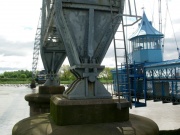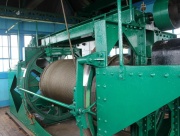Transporter Bridge, Newport
The Newport Transporter Bridge crosses the River Usk in Newport, South Wales.
Designed by French engineer Ferdinand Arnodin, it was built in 1906 and opened by Godfrey Charles Morgan, 1st Viscount Tredegar on 12 September 1906. Contractor: Alfred Thorne and Sons. Steelwork was supplied by the Cleveland Bridge and Engineering Co; the cables were furnished by W. B. Brown and Co., Limited, of Liverpool, and the electrical apparatus by R. W. Blackwell, Limited, of Westminster.
The design was chosen because the river banks are very low at the desired crossing point (a few miles south of the city centre) where an ordinary bridge would need a very long approach ramp to attain sufficient height to allow ships to pass under, and a ferry could not be used during low tide at the site.
The height of the towers is 242 feet and the height of the horizontal beam above the road is 177 feet. The transporter platform or gondola travels the 645 feet between the towers at ten feet (three metres) per second, powered from the engine room.
The design was described in The Engineer in 1906 (see 'See Also'). The main span is supported by a combination of suspension cables and cable stays. The main span's girder construction is interesting: there are vertical struts separating the top and bottom beams, acting in compression, while cables provide the diagonal ties, working only in tension.
Access
The bridge has been restored to operation, carrying vehicles and pedestrians. For a small fee, visitors can climb the stairs and walk across the main span, and return the same way or descend and return on the gondola. This is an excellent opportunity, and offers good views of the area. Currently (2014) access is available for 5 days a week for 6 months (spring - autumn), subject to the weather and various other constraints (including the ability to climb 270 steps and walk across the floor gratings!). See website [1] for details.
See Also
Sources of Information
- [2] Wikipedia


















